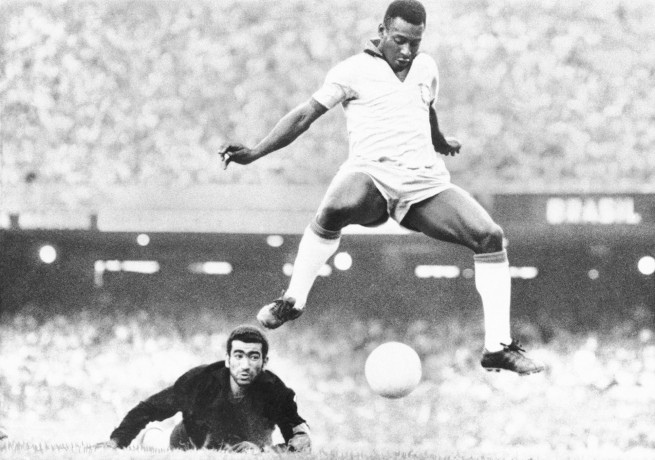
Pelé was basically “The King.” He grasped “the excellent game” of soccer in his 1958 World Glass make a big appearance for Brazil and never truly let go.
He won a record three World Glasses and was broadly respected as one of his sport’s most noteworthy players. His grand and galvanizing nearness set him among the most recognizable figures in the world.
Pelé passed on Thursday at 82. He had experienced treatment for colon cancer since 2021.
Pelé was among the game’s most productive scorers and went through about two decades charming fans and astonishing adversaries. His elegance, physicality and moves on soccer’s most noteworthy organize transfixed all. He organized a quick, liquid fashion of play that revolutionized the don — a pizazz that exemplified Brazilian tastefulness on the field.
He carried his nation to soccer’s statures and got to be a worldwide minister for his don in a travel that started on the lanes of Sao Paulo state, where he would kick a sock stuffed with daily papers or rags.
“Pelé changed everything. He changed football into craftsmanship, entertainment,” Neymar, a individual Brazilian soccer player, said on Instagram. “Football and Brazil lifted their standing much obliged to the Ruler! He is gone, but his enchantment will persevere. Pelé is eternal!”
In the discussion around soccer’s most noteworthy player, as it were the late Diego Maradona, Lionel Messi and Cristiano Ronaldo are specified nearby him.
Different sources, checking diverse sets of diversions, list Pelé’s objective sums anyplace between 650 (alliance matches) to 1,281 (all senior matches, a few against low-level competition). When Maradona once met Pelé, he energetically inquired the Brazilian how he gathered so numerous goals.
The player who would be named “The King” was presented to the world at 17 at the 1958 World Container in Sweden, the most youthful player ever at the tournament.
Pelé was the insignia of his country’s World Glass triumph of 1970 in Mexico. He scored in the last and set up Carlos Alberto with a impassive pass for the final objective in a 4-1 triumph over Italy.
The picture of Pelé in a bright-yellow Brazil shirt, with the No. 10 stamped on the back, remains lively with soccer fans all over. As does his trademark objective celebration — a jump with a right clench hand pushed tall over his head.
Pelé’s popularity was such that in 1967 groups of a gracious war in Nigeria concurred to a brief cease-fire so he might play an presentation coordinate in the nation. He was knighted by Britain’s Ruler Elizabeth II in 1997. When Pelé gone to Washington to offer assistance popularize the diversion in North America, it was the U.S. president who stuck out his hand first.
“You don’t require to present yourself since everybody knows who Pelé is,” Ronald Reagan said.
Pelé was Brazil’s to begin with present day Dark national saint but once in a while talked almost bigotry in a nation where the wealthy and capable tend to salute from the white minority.
Opposing fans insulted Pelé with monkey chants at domestic and all over the world.
“He said that he would never play if he had to halt each time he listened those chants,” said Angelica Basthi, one of Pelé’s biographers. “He is key for Dark people’s pride in Brazil, but never needed to be a flagbearer.”
Pelé’s life after soccer took numerous shapes. He was a lawmaker — Brazil’s Uncommon Serve for Wear — a affluent businessman, and an minister for UNESCO and the Joined together Nations.
He had parts in motion pictures, cleanser musical dramas and indeed composed tunes and recorded CDs of well known Brazilian music.
Pelé was an envoy for his wear until his last a long time but as his wellbeing weakened his voyages and appearances got to be less visit. After requiring a hip substitution, he begun utilizing a cane.
He was regularly seen in a wheelchair amid his last a long time and did not go to a ceremony to reveal a statue of him speaking to Brazil’s 1970 World Glass team.
“He gets exceptionally bashful, he gets exceptionally embarrassed,” his child Edinho told Globoesporte.com. “He doesn’t need to go out.”
Pelé went through his 80th birthday with a few relatives.
Pelé went through a month hospitalized in 2021 after surgery to evacuate a tumor from his colon. Pelé said he was prepared “to play 90 minutes, additionally additional time,” but before long begun chemotherapy.
Born Edson Arantes do Nascimento, in the little city of Tres Coracoes in the insides of Minas Gerais state on Oct. 23, 1940, Pelé developed up sparkling shoes to purchase his humble soccer adapt. His father was too a player.
Pelé’s ability drew take note when he was 11, and a nearby proficient player brought him to Santos’ youth squads. In spite of his youth and 5-foot-8 outline Pelé’ scored against developed men with the same ease he shown against companions back domestic. He debuted with the Brazilian club at 15 in 1956, and the club rapidly picked up around the world recognition.
The title Pelé came from him misspeaking the title of a player called Bilé. He afterward got to be known essentially as ‘O Rei’ – The King.
Pelé went to the 1958 World Glass as a save but got to be a key portion for his country’s championship group. His to begin with objective, in which he flicked the ball over the head of a guard and dashed around him to volley it domestic, was voted as one of the best in World Container history.
“When Pelé scored,” ingenious Swedish midfielder Sigge Parling said, “I have to be fair and say I felt like applauding.”
The 1966 World Glass in Britain — won by the has — was a biting one for Pelé, by at that point as of now considered the world’s beat player. Brazil was thumped out at the gather arrange and Pelé, irate at fouls and difficult handles by Portugal, swore it was his final World Cup.
He changed his intellect and was revived in the 1970 World Glass. In a diversion against Britain, he struck a header for a certain score, but the awesome goalkeeper Gordon Banks flipped the ball over the bar in an astounding move. Pelé compared the spare — one of the best in World Container history — to a “salmon climbing up a waterfall.” Afterward, he scored the opening objective in the last against Italy, his final World Container match.
In all, Pelé played 114 matches with Brazil, scoring a record 95 objectives — counting 77 in official matches. Most of his objectives came with Santos, which he driven to five national titles, two Copa Libertadores trophies and two club world championships — all in the 1960s.
His run with Santos extended over three decades until he went into semi-retirement after the 1972 season. Well off European clubs attempted to sign him, but the Brazilian government mediated to keep him from being sold, pronouncing him a national treasure.
On the field, Pelé’s vitality, vision and creative ability drove a skilled Brazilian national group, with complex passing combinations cutting protections whereas taking off room for players to grandstand garish skills.
The quick, liquid fashion of play exemplified “O Jogo Bonito” — Portuguese for “The Excellent Game.” And at the center of it all, like a maestro in command of his symphony, was Pelé. It was his 1977 personal history, “My Life and the Excellent Game,” that made the express portion of soccer’s lexicon.
In 1975, he joined the Unused York Universe of the North American Soccer Alliance. In spite of the fact that he was past his prime at 34 a long time ancient, Pelé briefly gave soccer a higher profile in North America some time recently finishing his career on Oct. 1, 1977, in an presentation between the Universe and Santos. Among the dignitaries on hand was maybe the as it were other competitor whose eminence traversed the globe — Muhammad Ali.
Pelé had two girls out of wedlock and five children from his to begin with two relational unions, to Rosemeri dos Reis Cholbi and Assiria Seixas Lemos. He afterward hitched businesswoman Marcia Cibele Aoki.
Pele, who charmed fans and astonished adversaries, passes on at 82
Pelé was basically “The King.” He grasped “the excellent game” of soccer in his 1958 World Glass make a big appearance for Brazil and never truly let go.
He won a record three World Glasses and was broadly respected as one of his sport’s most noteworthy players. His grand and galvanizing nearness set him among the most recognizable figures in the world.
Pelé passed on Thursday at 82. He had experienced treatment for colon cancer since 2021.
Pelé was among the game’s most productive scorers and went through about two decades charming fans and astonishing adversaries. His elegance, physicality and moves on soccer’s most noteworthy organize transfixed all. He organized a quick, liquid fashion of play that revolutionized the don — a pizazz that exemplified Brazilian tastefulness on the field.
He carried his nation to soccer’s statures and got to be a worldwide minister for his don in a travel that started on the lanes of Sao Paulo state, where he would kick a sock stuffed with daily papers or rags.
“Pelé changed everything. He changed football into craftsmanship, entertainment,” Neymar, a individual Brazilian soccer player, said on Instagram. “Football and Brazil lifted their standing much obliged to the Ruler! He is gone, but his enchantment will persevere. Pelé is eternal!”
In the discussion around soccer’s most noteworthy player, as it were the late Diego Maradona, Lionel Messi and Cristiano Ronaldo are specified nearby him.
Different sources, checking diverse sets of diversions, list Pelé’s objective sums anyplace between 650 (alliance matches) to 1,281 (all senior matches, a few against low-level competition). When Maradona once met Pelé, he energetically inquired the Brazilian how he gathered so numerous goals.
The player who would be named “The King” was presented to the world at 17 at the 1958 World Container in Sweden, the most youthful player ever at the tournament.
Pelé was the insignia of his country’s World Glass triumph of 1970 in Mexico. He scored in the last and set up Carlos Alberto with a impassive pass for the final objective in a 4-1 triumph over Italy.
The picture of Pelé in a bright-yellow Brazil shirt, with the No. 10 stamped on the back, remains lively with soccer fans all over. As does his trademark objective celebration — a jump with a right clench hand pushed tall over his head.
Pelé’s popularity was such that in 1967 groups of a gracious war in Nigeria concurred to a brief cease-fire so he might play an presentation coordinate in the nation. He was knighted by Britain’s Ruler Elizabeth II in 1997. When Pelé gone to Washington to offer assistance popularize the diversion in North America, it was the U.S. president who stuck out his hand first.
“You don’t require to present yourself since everybody knows who Pelé is,” Ronald Reagan said.
Pelé was Brazil’s to begin with present day Dark national saint but once in a while talked almost bigotry in a nation where the wealthy and capable tend to salute from the white minority.
Opposing fans insulted Pelé with monkey chants at domestic and all over the world.
“He said that he would never play if he had to halt each time he listened those chants,” said Angelica Basthi, one of Pelé’s biographers. “He is key for Dark people’s pride in Brazil, but never needed to be a flagbearer.”
Pelé’s life after soccer took numerous shapes. He was a lawmaker — Brazil’s Uncommon Serve for Wear — a affluent businessman, and an minister for UNESCO and the Joined together Nations.
He had parts in motion pictures, cleanser musical dramas and indeed composed tunes and recorded CDs of well known Brazilian music.
Pelé was an envoy for his wear until his last a long time but as his wellbeing weakened his voyages and appearances got to be less visit. After requiring a hip substitution, he begun utilizing a cane.
He was regularly seen in a wheelchair amid his last a long time and did not go to a ceremony to reveal a statue of him speaking to Brazil’s 1970 World Glass team.
“He gets exceptionally bashful, he gets exceptionally embarrassed,” his child Edinho told Globoesporte.com. “He doesn’t need to go out.”
Pelé went through his 80th birthday with a few relatives.
Pelé went through a month hospitalized in 2021 after surgery to evacuate a tumor from his colon. Pelé said he was prepared “to play 90 minutes, additionally additional time,” but before long begun chemotherapy.
Born Edson Arantes do Nascimento, in the little city of Tres Coracoes in the insides of Minas Gerais state on Oct. 23, 1940, Pelé developed up sparkling shoes to purchase his humble soccer adapt. His father was too a player.
Pelé’s ability drew take note when he was 11, and a nearby proficient player brought him to Santos’ youth squads. In spite of his youth and 5-foot-8 outline Pelé’ scored against developed men with the same ease he shown against companions back domestic. He debuted with the Brazilian club at 15 in 1956, and the club rapidly picked up around the world recognition.
The title Pelé came from him misspeaking the title of a player called Bilé. He afterward got to be known essentially as ‘O Rei’ – The King.
Pelé went to the 1958 World Glass as a save but got to be a key portion for his country’s championship group. His to begin with objective, in which he flicked the ball over the head of a guard and dashed around him to volley it domestic, was voted as one of the best in World Container history.
“When Pelé scored,” ingenious Swedish midfielder Sigge Parling said, “I have to be fair and say I felt like applauding.”
The 1966 World Glass in Britain — won by the has — was a biting one for Pelé, by at that point as of now considered the world’s beat player. Brazil was thumped out at the gather arrange and Pelé, irate at fouls and difficult handles by Portugal, swore it was his final World Cup.
He changed his intellect and was revived in the 1970 World Glass. In a diversion against Britain, he struck a header for a certain score, but the awesome goalkeeper Gordon Banks flipped the ball over the bar in an astounding move. Pelé compared the spare — one of the best in World Container history — to a “salmon climbing up a waterfall.” Afterward, he scored the opening objective in the last against Italy, his final World Container match.
In all, Pelé played 114 matches with Brazil, scoring a record 95 objectives — counting 77 in official matches. Most of his objectives came with Santos, which he driven to five national titles, two Copa Libertadores trophies and two club world championships — all in the 1960s.
His run with Santos extended over three decades until he went into semi-retirement after the 1972 season. Well off European clubs attempted to sign him, but the Brazilian government mediated to keep him from being sold, pronouncing him a national treasure.
On the field, Pelé’s vitality, vision and creative ability drove a skilled Brazilian national group, with complex passing combinations cutting protections whereas taking off room for players to grandstand garish skills.
The quick, liquid fashion of play exemplified “O Jogo Bonito” — Portuguese for “The Excellent Game.” And at the center of it all, like a maestro in command of his symphony, was Pelé. It was his 1977 personal history, “My Life and the Excellent Game,” that made the express portion of soccer’s lexicon.
In 1975, he joined the Unused York Universe of the North American Soccer Alliance. In spite of the fact that he was past his prime at 34 a long time ancient, Pelé briefly gave soccer a higher profile in North America some time recently finishing his career on Oct. 1, 1977, in an presentation between the Universe and Santos. Among the dignitaries on hand was maybe the as it were other competitor whose eminence traversed the globe — Muhammad Ali.
Pelé had two girls out of wedlock and five children from his to begin with two relational unions, to Rosemeri dos Reis Cholbi and Assiria Seixas Lemos. He afterward hitched businesswoman Marcia Cibele Aoki.







